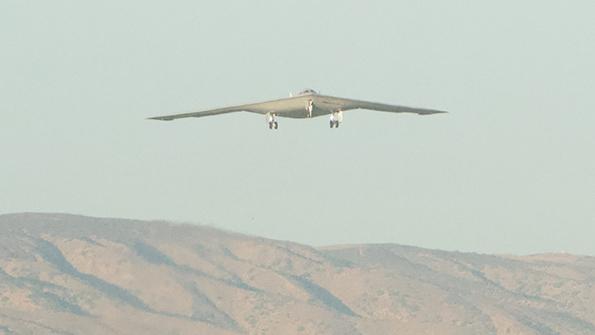
The B-21’s public first flight in mid-November marked the beginning of an intensive and secretive test process.
In a first flight that caught the world’s attention in November, the U.S. Air Force’s B-21 next-generation stealth bomber took off to start flight tests.
The program’s progress caused Air Force Secretary Frank Kendall to slightly bend the key rule on Pentagon acquisition he developed over years in the building: to not say something positive about a program in development.
- Air Force secretary says he is “cautiously optimistic”
- Six of the aircraft are in production at Northrop Grumman
“They all have risk, and there is a good chance that whatever program it is—no matter how well it’s done to date—it’s going to get in trouble. . . . But I’m fairly optimistic about B-21,” Kendall said shortly after the first flight.
Early on the sunny morning of Nov. 10 in Palmdale, California, the B-21 taxied in the daylight and took off from the same runway that its predecessor, the B-2 Spirit, did 34 years earlier. Accompanied by an F-16 in service as its chase plane, the bomber flew over a crowd of onlookers outside the gate of the secretive Plant 42 on its way to start flight testing at Edwards AFB, California. The first flight is estimated to have lasted about 1 hr. and 40 min.
- See more images from the B-21's first flight: Gallery: New Images Emerge Of The Secretive B-21 Stealth Bomber
- Read former Aviation Week defense editor Bill Sweetman’s analysis of the B-21 design and see updated diagrams and cutaways by Giuseppe Picarella/TheCutawayCompany.com
“It’s flying now; it’s in flight test,” Kendall said during a Nov. 13 event hosted by the Center for a New American Security. “That’s an important milestone. We’ve got a ways to go on the flight testing, and then we’ve obviously got to go through production and make that work. But where we are with the program, I can say cautious optimism is warranted, but we can still find issues that we have to address and I expect we will.”
In a statement to Aviation Week shortly after the B-21 took off, the Air Force said the bomber’s flight test will be a “critical step in the test campaign.” The test process, which is managed by the Air Force Test Center and the 412th Test Wing’s B-21 Combined Test Force, looks to ensure the aircraft will provide survivable, long-range penetrating strike capabilities that the stealth bomber mission requires.
Video of the flight confirms the flying-wing aircraft has a simple W-shape trailing edge and reveals an extremely clean design with an almost featureless underside. The deeper centerbody compared with the B-2 is evident, with the undersurface between the main and nose gear essentially flat. The cambered leading edges also are evident, as are the trailing-edge control surfaces, including the outer split surface drag rudders.
The aircraft was seen sporting the name and image of Cerberus, the three-headed hound of Hades that guards the gates of the underworld in Greek mythology.
The flight came less than a month after the B-21 was spotted conducting taxi tests in the daylight at Palmdale. Northrop Grumman first ran the aircraft’s engines in September. The company created a fuel system simulator that was able to derisk fuel transfer, allowing it to go from fueling to engine runs in about five days. That was “unheard of . . . particularly in a flying-wing type of design where fuel movement is all the more important,” says Thomas Jones, Northrop Grumman’s president of aeronautic systems.
Ahead of the flight, Northrop Grumman had rolled the aircraft out, while the Air Force released more photos but remained tight-lipped about its progress.
“We’re being a little bit ambiguous because in the world of aviation aficionados and journalists wanting to know when first flight is, the adversary does, too. So we’re not really giving specifics of how much longer we’ve got,” Jones said before the flight.
The B-21 is in its engineering and manufacturing development phase, on track to deliver aircraft to its first operating base and training unit at Ellsworth AFB, South Dakota, in the mid-2020s. The bomber will also be based at Whiteman AFB, Missouri, and Dyess AFB, Texas, pending an environmental impact statement. The service wants a minimum of 100 of the aircraft to replace both the Rockwell B-1B Lancer and Northrop Grumman B-2 fleets.
Six of the aircraft are in production at Northrop Grumman, where the company is using the same production line and tooling as upcoming production aircraft.
The first flight is a major milestone for Northrop Grumman in more ways than one. The Air Force required a successful first flight before awarding the first low-rate initial production contract for the program, which is expected soon. However, the company does not expect to see profit immediately on the program, CEO Kathy Warden said during a third-quarter earnings call.
“We are planning at a zero profitability, but we have to perform and we are working hard to ensure that,” Warden said.
The Air Force, in its fiscal 2024 budget request, calls for $5.64 billion in B-21 research and development funding, a number that increases over the next five years and amounts to a total of $34.8 billion. For procurement, that total over the next five years will be $20.8 billion.
